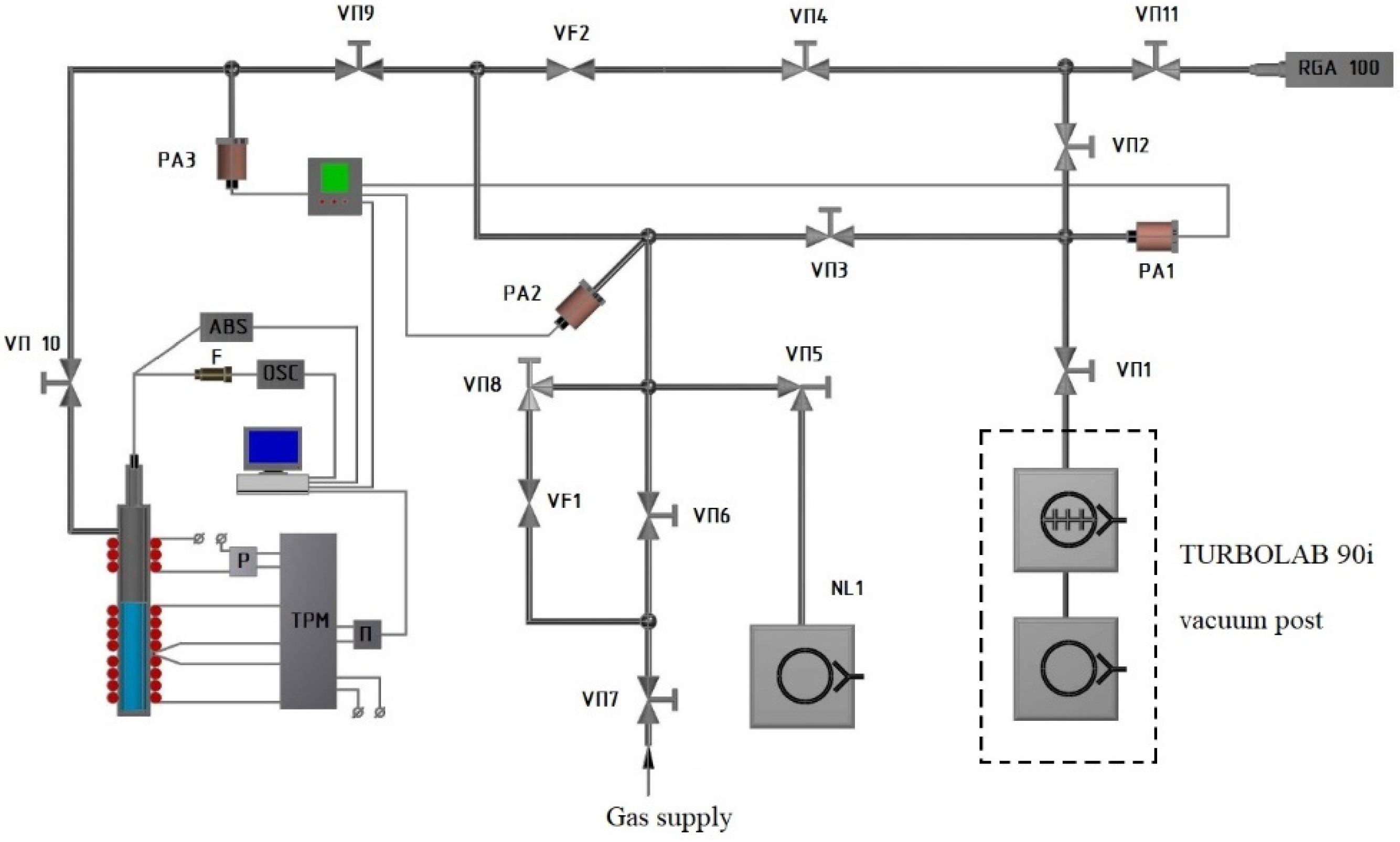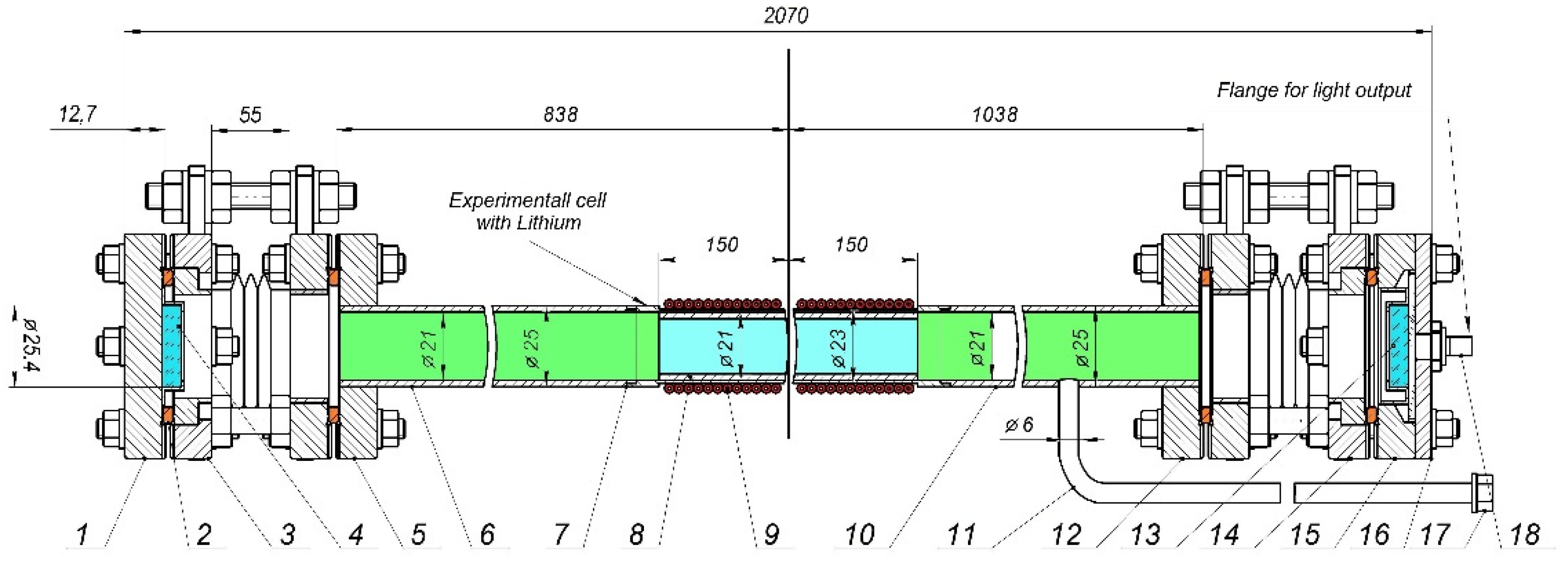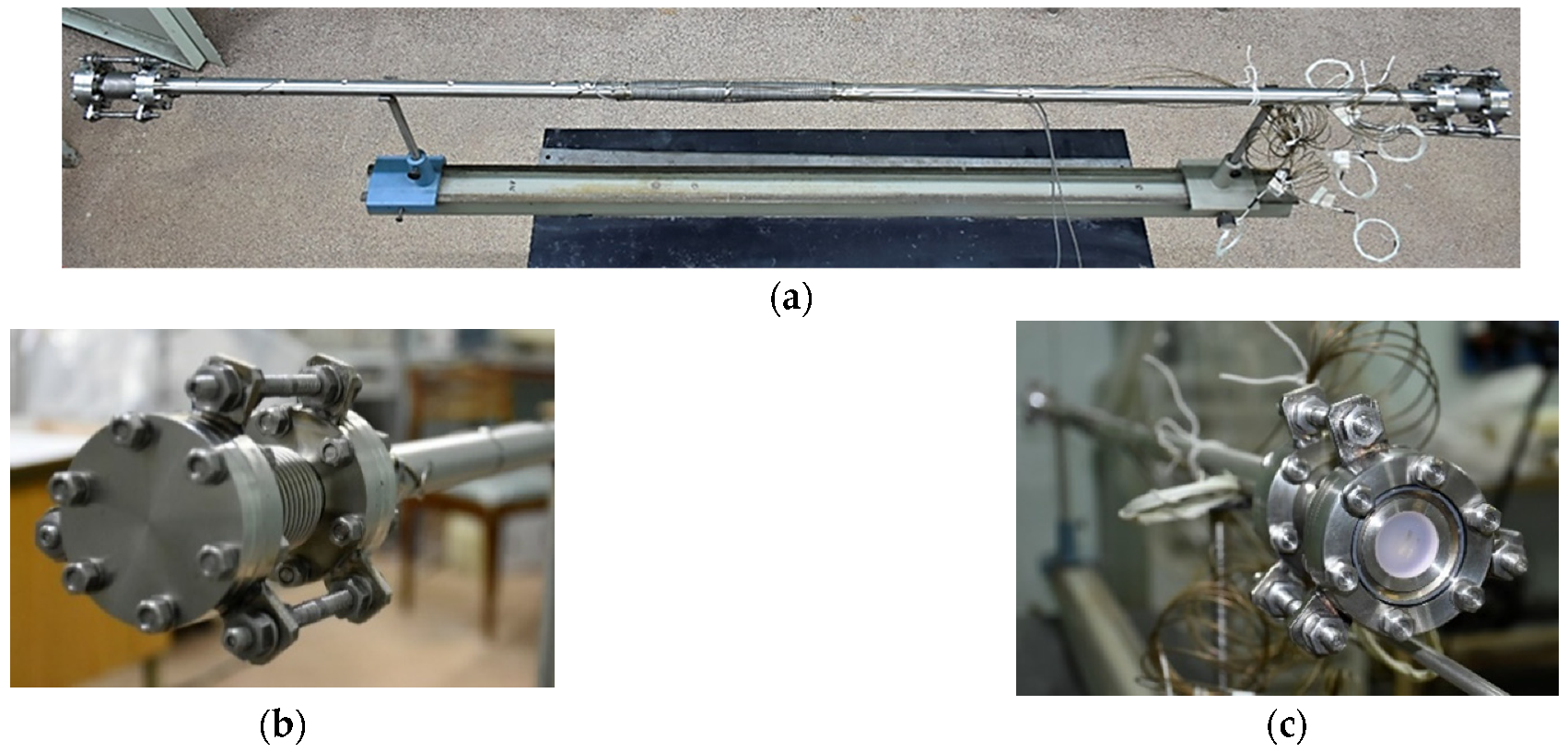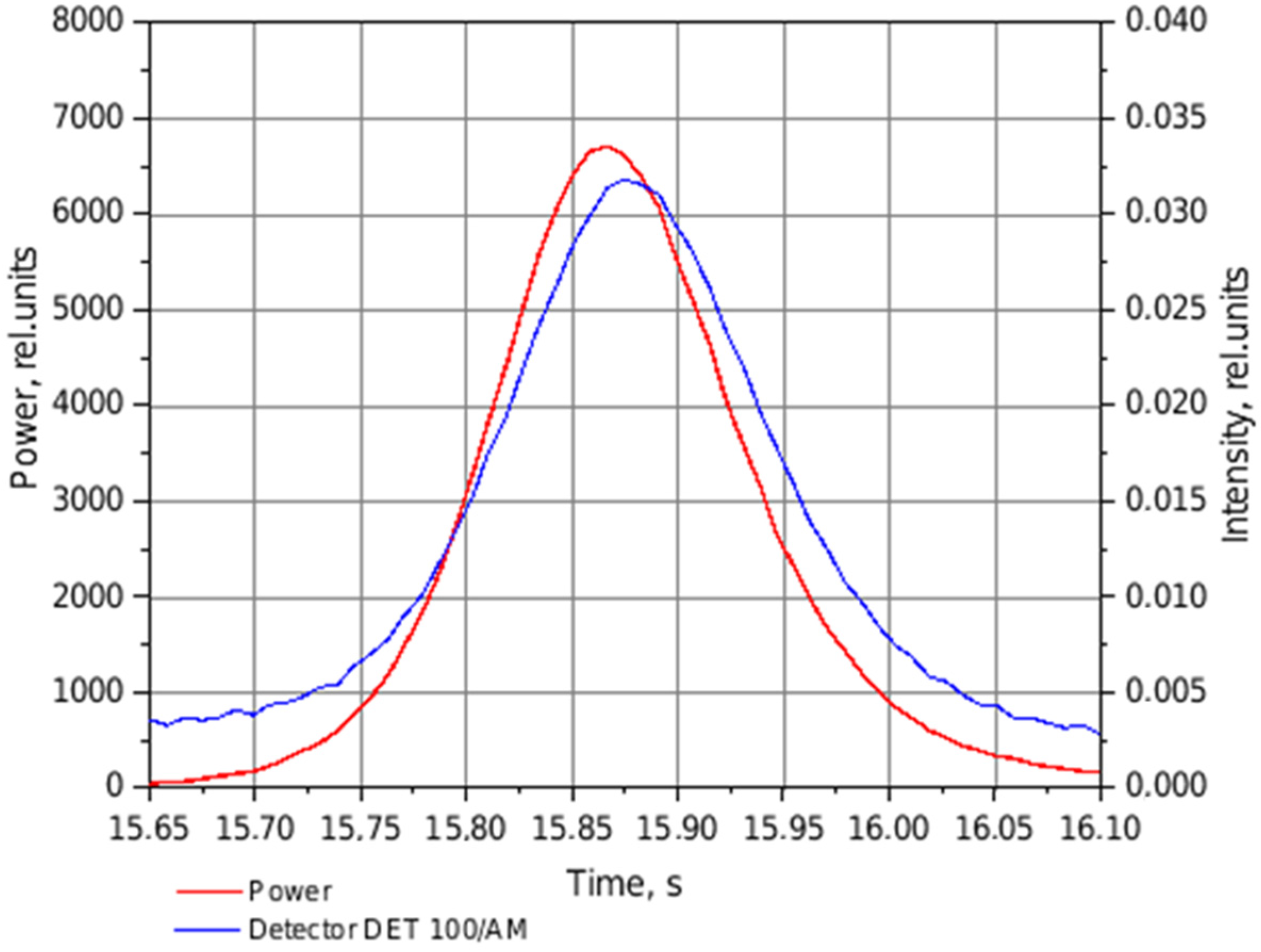Experimental Facility to Study the Threshold Characteristics of Laser Action at the p-s-Transition of Noble Gas Atom upon Excitation by 6Li(n,α)3H Nuclear Reaction Products
Abstract
:1. Introduction
2. Experimental Technique
2.1. Neutron Flux Source, IGR Reactor
2.2. Experimental Facility
- Gas–vacuum system;
- Information measuring system (IMS);
- Experimental irradiation device (ID).
- Turbomolecular pumping system (TURBOLAB 90i 63ISO-K/SC7plus/F/N vacuum post);
- Shut-off valve (vacuum valves, breakers);
- Pressure measurement means (vacuum sensors);
- Quadrupole probe (sensor) of mass-spectrometer RGA-100;
- Pipelines connecting elements of a gas–vacuum system.
- System of temperature adjustment and registration of ID housing (provides heating and stabilization of ID housing temperature set during annealing at the preliminary stage of experiments);
- Optical system of light signal registration (provides registration of light radiation within a wavelength range from 200 nm to 2500 nm, occurring in a volume of ID active cell);
- Mass-spectrometric system of gas analysis (serves for gas phase identification in ID volume and registration of gas partial pressure in real time mode during preparation for experiments).
2.3. Experimental Irradiation Device with a Lithium Source of Gas Media Excitation
- experimental cell of ID;
- light flux output node.
- On the lower part of the cell near the aligner flange (1 pc.);
- On the middle part of the ID experimental cell;
- At the level of the lower end of lithium CPS (1 pc.);
- At the level of the central part of lithium CPS (2 pcs.);
- At the level of the upper end of lithium CPS (1 pc.);
- On the upper part of the cell;
- At the level of pumping pipeline joints (1 pc);
- Near the upper flange of aligner (1 pc.).
3. Results and Discussion
4. Conclusions
5. Patents
Author Contributions
Funding
Institutional Review Board Statement
Informed Consent Statement
Data Availability Statement
Acknowledgments
Conflicts of Interest
References
- Mel’nikov, S.P.; Sinyanskii, A.A.; Sizov, A.N.; Miley, G.H. Lasers with Nuclear Pumping; Springer: New York, NY, USA, 2015; p. 455. [Google Scholar]
- Prelas, M. Nuclear Pumped Lasers; Springer International Publishing: Cham, Switzerland, 2016; p. 417. [Google Scholar]
- Batyrbekov, E. Converting nuclear energy into the energy of coherent optical radiation. Laser Part. Beams 2013, 31, 673–687. [Google Scholar] [CrossRef]
- Apruzzese, G.M.; Apicella, M.L.; Maddaluno, G.; Mazzitelli, G.; Viola, B. Spectroscopic measurements of lithium influx from an actively water-cooled liquid lithium limiter on FTU. Fusion Eng. Des. 2017, 117, 145–149. [Google Scholar] [CrossRef]
- Mis’kevich, A.I. Visible and near-infrared direct nuclear pumped lasers. Laser Phys. 1991, 1, 445–481. [Google Scholar]
- Gordienko, Y.; Batyrbekov, E.; Skakov, M.; Ponkratov, Y.; Khasenov, M.; Zaurbekova, Z.; Barsukov, N.; Kulsartov, T.; Tulubayev, Y. Experimental facility for reactor experiments on study of spectral-luminescent characteristics of nuclear-excited plasma. J. Phys. Conf. Ser. 2016, 747, 012012. [Google Scholar] [CrossRef] [Green Version]
- Gordienko, Y.; Khasenov, M.; Batyrbekov, E.; Samarkhanov, K.; Ponkratov, Y.; Amrenov, A. Emission of noble gases and their mixtures with lithium excited by products of 6Li(n,α)3H nuclear reaction. Laser Part. Beams. 2019, 37, 18–24. [Google Scholar] [CrossRef]
- Batyrbekov, E.; Khasenov, M.; Gordienko, Y.; Samarkhanov, K.; Ponkratov, Y. Optical radiation from the sputtered species under gas excitation by the products of the 6Li(n,α)3H nuclear reaction. J. Lumin. 2020, 220, 116973. [Google Scholar] [CrossRef]
- Samarkhanov, K.; Khasenov, M.; Batyrbekov, E.; Kenzhina, I.; Sapatayev, Y.; Bochkov, V. Emission of Noble Gases Binary Mixtures under Excitation by the Products of the 6Li(n, α)3H Nuclear Reaction. Sci. Technol. Nucl. Install. 2020, 2020, 8891891. [Google Scholar] [CrossRef]
- Samarkhanov, K.; Khasenov, M.; Batyrbekov, E.; Gordienko, Y.; Baklanova, Y.; Kenzhina, I.; Tulubayev, Y.; Karambayeva, I. Optical Radiation from the Sputtered Species under Excitation of Ternary Mixtures of Noble Gases by the 6Li(n,α)3H Nuclear Reaction Products. Eurasian Chem. Technol. J. 2021, 23, 95–102. [Google Scholar] [CrossRef]
- Lamotte, M.; de Izarra, G.; Jammes, C. Development and first use of an experimental device for fission-induced spectrometry applied to neutron flux monitoring. Nucl. Instrum. Methods Phys. Res. A Accel. Spectrom. Detect. Assoc. Equip. 2020, 953, 163236. [Google Scholar] [CrossRef]
- Lamotte, M.; de Izarra, G.; Jammes, C. Pulse-reactor core monitoring with an innovative optical neutron detector. Nucl. Instrum. Methods Phys. Res. A Accel. Spectrom. Detect. Assoc. Equip. 2021, 995, 165086. [Google Scholar] [CrossRef]
- Lamotte, M.; de Izarra, G.; Jammes, C. Design and irradiation test of an innovative optical ionization chamber technology. Nucl. Instrum. Methods Phys. Res. A Accel. Spectrom. Detect. Assoc. Equip. 2020, 968, 163945. [Google Scholar] [CrossRef]
- Vityuk, V.; Vurim, A. Method for determining the energy parameters in pulse reactor experiments. Ann. Nucl. Energy 2019, 127, 196–203. [Google Scholar] [CrossRef]
- Tskhe, V.K.; Mukhamedov, N.Y.; Gaydaychuk, V.A.; Kozlovskiy, Y.V.; Gradoboev, A.V. The method of the reactivity margin calculation required for the IGR reactor start-up in the “Pulse” mode. Ann. Nucl. Energy 2022, 168, 108875. [Google Scholar] [CrossRef]
- Batyrbekov, E.G.; Khassenov, M.U.; Samarkhanov, K.K.; Gordienko, Y.N.; Ponkratov, Y.V.; Tulubayev, Y.Y.; Bochkov, V.S. Patent for Utility Model “Irradiation Device for Conducting Experiments on Pulsed Graphite Reactor”. No. 7162, 3 June 2022 G21C 23/00 (2006.01); Bulletin No. 22; 3 June 2022. Available online: https://kazpatent.kz/en/content/poleznaya-model-03062022 (accessed on 3 June 2022).
- Abramov, A.; Gorbunov, V.; Melnikov, S.; Mukhamatullin, A.; Pikulev, A.; Sinitsyn, A.; Sinyanskii, A.; Tsvetkov, V. Luminescence of nuclear-induced rare-gas plasmas in near infrared spectral range. In Proceedings of the Atomic and Molecular Pulsed Lasers VI, Tomsk, Russia, 12–16 September 2005; SPIE Press: Bellingham, DC, USA, 2006; Volume 6263, p. 626312. [Google Scholar] [CrossRef]
- Barzilov, A.; Bokhovko, M.; Gulevich, A.; Dyachenko, P.; Kachanov, B.; Kononov, V.; Kukharchuk, O.; Pashin, E.; Regushevsky, V.; Zrodnikov, A. Theoretical and experimental studies of gaseous laser pumped by a twin-core fast burst reactor. In Proceedings of the AIP Conference Proceedings, Monterey, CA, USA, 13–18 April 1997; American Institute of Physics: College Park, MD, USA, 1997; Volume 406, pp. 351–358. [Google Scholar] [CrossRef]
- Mel’nikov, S.; Sinyanskiĭ, A. Quasi-cw lasing due to the 4p–4s transition of the argon atom in an He–Ar laser pumped by uranium fission fragments. Sov. J. Quantum Electron. 1991, 21, 1332. [Google Scholar] [CrossRef]









| Parameter of Reactor | Value of Reactor |
|---|---|
| Initial reactivity leap | Not more 5 βeff |
| Maximal power of reactor in “BURST” mode | Not more 10 GW |
| Maximal neutron flux density in IGR CEC | ~7 × 1016 n/(cm2∙s) |
| Parts | Type (grade) | Parameters |
|---|---|---|
| Optical fiber | BIF600-VIS + NIR | spectral range: 400–2500 nm |
| P-600-10-UV + VIS | spectral range: 300–1100 nm | |
| P-600-10-VIS + NIR | spectral range: 400–2100 nm | |
| Optical spectrometer | QE-Pro-abs | spectral range: 200–950 nm |
| High-Speed Fiber-Coupled Detectors | silicon detector (DET100A) | Rise time 35 ns, spectral range: 320 nm–1100 nm; |
| silicon detector (DET25A/M) | Rise time 1 ns spectral range 400 nm–1100 nm | |
| Indium–gallium detector (DET08CFC/M–InGaAs) | Bandwidth 5 GHz, rise time 70 ps spectral range: 800 nm up to 1700 nm | |
| PMT module | PDM02-9113W-CN | spectral range: 280–850 nm; |
| MDR-204 monochromator | spectral range: 190–5000 nm | |
| oscilloscope | Tektronix TBS 2204B | 200 MHz Bandwidth |
| Tektronix TPS 2012 | 100 MHz Bandwidth | |
| quadrupole mass-spectrometer | RGA-100 | measured mass range is from 1 a.m.u. up to 100 a.m.u. |
| pressure sensor | VSR53D | working range: 1·10−4–750 Torr |
| MTM 9D | working range: 1·10−9–750 Torr | |
| pressure sensor controller | VD10 | Power supply: alternating current, voltage from 95 V to 265 V, 50/60 Hz Consumed power–25 W |
Publisher’s Note: MDPI stays neutral with regard to jurisdictional claims in published maps and institutional affiliations. |
© 2022 by the authors. Licensee MDPI, Basel, Switzerland. This article is an open access article distributed under the terms and conditions of the Creative Commons Attribution (CC BY) license (https://creativecommons.org/licenses/by/4.0/).
Share and Cite
Batyrbekov, E.; Khasenov, M.; Gordienko, Y.; Samarkhanov, K.; Kenzhina, I.E.; Kotlyar, A.; Miller, A.; Tskhe, V.; Bochkov, V. Experimental Facility to Study the Threshold Characteristics of Laser Action at the p-s-Transition of Noble Gas Atom upon Excitation by 6Li(n,α)3H Nuclear Reaction Products. Appl. Sci. 2022, 12, 12889. https://doi.org/10.3390/app122412889
Batyrbekov E, Khasenov M, Gordienko Y, Samarkhanov K, Kenzhina IE, Kotlyar A, Miller A, Tskhe V, Bochkov V. Experimental Facility to Study the Threshold Characteristics of Laser Action at the p-s-Transition of Noble Gas Atom upon Excitation by 6Li(n,α)3H Nuclear Reaction Products. Applied Sciences. 2022; 12(24):12889. https://doi.org/10.3390/app122412889
Chicago/Turabian StyleBatyrbekov, Erlan, Mendykhan Khasenov, Yuriy Gordienko, Kuanysh Samarkhanov, Inesh E. Kenzhina, Andrey Kotlyar, Alexandr Miller, Valentin Tskhe, and Vadim Bochkov. 2022. "Experimental Facility to Study the Threshold Characteristics of Laser Action at the p-s-Transition of Noble Gas Atom upon Excitation by 6Li(n,α)3H Nuclear Reaction Products" Applied Sciences 12, no. 24: 12889. https://doi.org/10.3390/app122412889





